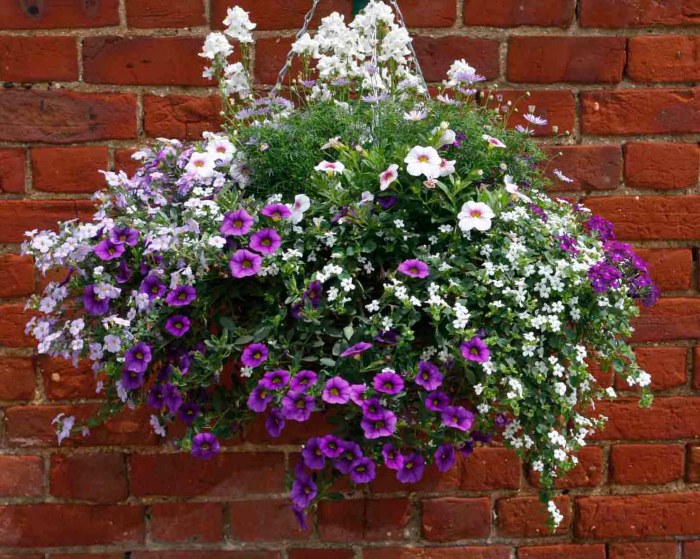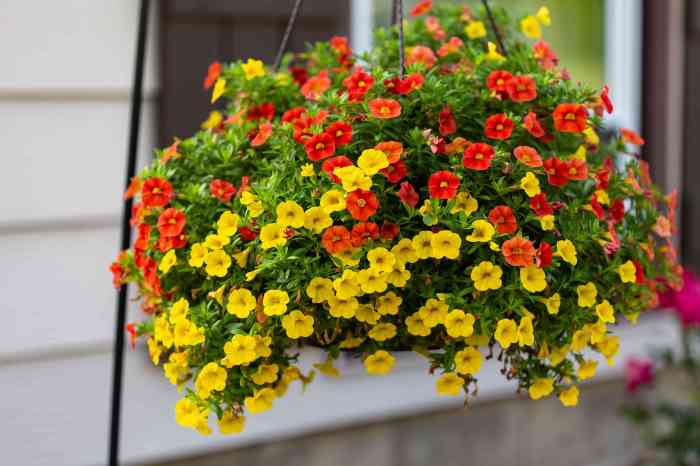Hanging basket plants to grow offer a unique way to add color, texture, and interest to both indoor and outdoor spaces. Whether you’re a seasoned gardener or just starting out, this comprehensive guide will provide you with everything you need to know about selecting, designing, and caring for hanging basket plants.
From choosing the right plants to creating visually appealing arrangements, our experts will guide you through every step of the process. Discover the secrets to maintaining healthy and vibrant hanging baskets that will transform your home or garden into a breathtaking oasis.
Selecting Ideal Plants for Hanging Baskets
Hanging baskets are a delightful way to add color and charm to your outdoor spaces. When selecting plants for these containers, it’s essential to consider factors like sunlight requirements, growth habits, and blooming seasons.
Traditionally, trailing or cascading plants are preferred for hanging baskets as they gracefully flow over the edges, creating a stunning visual effect. These plants have long, slender stems that can reach lengths of several feet, making them perfect for adding height and drama to your arrangements.
Suitable Plant Varieties
Numerous popular and easy-to-grow plants are well-suited for hanging baskets. Some of the most common choices include:
- Petunias: These vibrant flowers bloom profusely in various colors, adding a cheerful touch to any setting.
- Trailing Lobelia: This delicate plant produces masses of small, bell-shaped flowers in blue, white, or purple.
- Verbena: Verbena is known for its clusters of brightly colored flowers that attract butterflies and hummingbirds.
- Fuchsias: Fuchsias are known for their elegant, dangling flowers that come in a wide range of colors and shapes.
- Trailing Geraniums: These versatile plants offer continuous blooms in a variety of colors, adding a touch of elegance to hanging baskets.
Considerations for Plant Selection
When selecting plants for hanging baskets, consider the following factors:
- Sunlight Requirements: Choose plants that match the sunlight conditions in your chosen location.
- Growth Habits: Consider the size and growth habits of the plants to ensure they fit well in your baskets.
- Blooming Seasons: Select plants with varying blooming seasons to maintain a colorful display throughout the year.
Designing Stunning Arrangements

Crafting visually captivating hanging basket arrangements requires careful planning and a keen eye for detail. By thoughtfully selecting complementary plant species based on their colors, textures, and sizes, you can create a harmonious display that delights the senses.
Layering for Depth and Fullness
Layering plants within a hanging basket adds depth and visual interest. Start with taller, upright plants in the center, surrounded by mid-sized plants with cascading foliage. Fill in the gaps with trailing plants that spill over the edges, creating a lush and cascading effect.
Incorporating Vertical Elements
Incorporating vertical elements, such as trellises or stakes, can add height and interest to hanging baskets. These structures provide support for climbing plants, allowing them to reach their full potential and create a more dynamic display.
Hanging basket plants are a great way to add color and life to your home or garden. They can be used to create a variety of different looks, from lush and tropical to elegant and understated. If you’re looking for a way to add some extra beauty to your outdoor space, consider adding some hanging basket plants.
For those in Australia, there are a number of great options to choose from, including petunias, geraniums, and impatiens. Hanging basket plants Australia are a popular choice for gardeners of all levels, and they’re sure to add a touch of beauty to your home.
Optimal Growing Conditions: Hanging Basket Plants To Grow

To ensure thriving hanging basket plants, optimal growing conditions are paramount, including adequate sunlight, proper watering and fertilizing, suitable soil quality and drainage, and effective pest and disease management.
Sunlight is crucial for photosynthesis, providing energy for plant growth. Most hanging basket plants prefer bright, indirect light, while some may tolerate partial shade or require full sun. Determine the light requirements of each plant species and position the baskets accordingly.
Watering and Fertilizing
Watering frequency depends on factors such as plant type, weather conditions, and basket size. Allow the top inch of soil to dry out between waterings, and avoid overwatering, which can lead to root rot. Use lukewarm water and water deeply, allowing excess water to drain out.
Fertilize hanging baskets regularly during the growing season, typically every two to four weeks. Use a balanced liquid fertilizer diluted to half strength. Avoid over-fertilizing, as it can burn the plants.
Soil Quality and Drainage
Hanging baskets require well-draining soil to prevent waterlogging. Use a commercial potting mix specifically formulated for hanging baskets, which typically contains a blend of peat moss, perlite, and vermiculite.
Ensure the baskets have adequate drainage holes to allow excess water to escape. If drainage is poor, the roots can become waterlogged and suffocate.
Pest and Disease Management
Hanging baskets can be susceptible to pests and diseases, especially in warm, humid environments. Regularly inspect the plants for signs of infestation or infection. Common pests include aphids, spider mites, and mealybugs, while diseases include powdery mildew and botrytis.
Control pests and diseases using organic or chemical methods, following the instructions on the product label. Neem oil, insecticidal soap, and horticultural oil are effective natural pest control options. For diseases, use fungicides specifically labeled for use on hanging basket plants.
Practical Care and Maintenance
Maintaining hanging baskets requires regular care to ensure optimal growth and longevity. This includes pruning, deadheading, repotting, and adjusting watering schedules based on weather conditions.
Pruning and Deadheading
Regular pruning helps maintain the desired shape and size of hanging baskets. Remove any dead, diseased, or damaged foliage promptly. Deadheading, the removal of spent flowers, encourages continuous blooming and prevents seed production, which can weaken the plant.
Repotting
As hanging basket plants grow, they may need to be repotted into a larger container. Choose a pot with adequate drainage holes and use a well-draining potting mix specifically designed for hanging baskets.
Watering, Hanging basket plants to grow
Monitor soil moisture regularly and adjust watering schedules based on weather conditions. Water thoroughly when the top inch of soil feels dry to the touch. Avoid overwatering, as this can lead to root rot.
Hanging basket plants are a great way to add color and life to your home. They can be used to create a variety of looks, from lush and tropical to elegant and understated. If you’re looking for hanging basket plants to grow, you’ll find a wide selection at hanging basket plants dobbies . They have a variety of plants to choose from, so you’re sure to find the perfect ones for your home.
Overwintering
In cold climates, hanging basket plants must be overwintered indoors. Bring them inside before the first frost and place them in a bright, cool location. Reduce watering and fertilize sparingly.
Self-Watering Systems
Self-watering systems can provide convenience and peace of mind. These systems deliver water directly to the plant’s roots, eliminating the need for frequent manual watering.
Creative Applications and Inspirations

Hanging baskets offer endless opportunities for creative expression and functional décor in both indoor and outdoor spaces. They transcend their traditional use as flower containers and inspire innovative applications that enhance the aesthetic and practical value of various environments.
From creating vertical gardens and privacy screens to adding pops of color and interest to balconies and patios, hanging baskets unleash a realm of possibilities.
Hanging basket plants add a touch of greenery and elegance to any indoor or outdoor space. They come in a variety of shapes, sizes, and colors, making them a versatile choice for any gardener. For those looking for inspiration, the hanging basket plant crossword clue 10 letters offers a fun and challenging way to test their knowledge of these popular plants.
With a little research, you can easily find the perfect hanging basket plants to grow for your home or garden.
Vertical Gardens
Hanging baskets can transform vertical spaces into lush green oases. By suspending them vertically on walls or fences, you can create eye-catching vertical gardens that add depth and dimension to small or narrow areas. These gardens are ideal for growing herbs, trailing plants, and other species that thrive in vertical environments.
Privacy Screens
Strategically placed hanging baskets can act as natural privacy screens, shielding outdoor spaces from prying eyes or unsightly views. By suspending baskets filled with dense foliage, such as ferns or ivy, you can create a living wall that provides both privacy and a touch of greenery.
Focal Points
Hanging baskets can serve as striking focal points in any space. By choosing baskets with unique shapes, colors, or textures, you can draw attention to specific areas of your garden, patio, or indoor room. Suspending baskets at varying heights creates a dynamic display that adds visual interest and depth.
Balconies, Patios, and Porches
Hanging baskets are a practical and stylish way to add color and life to balconies, patios, and porches. By suspending baskets from railings or hooks, you can create a vertical garden that maximizes space and adds a touch of nature to these outdoor living areas.
Experimentation with Materials
In addition to traditional materials like plastic and metal, hanging baskets come in a variety of innovative materials that offer unique aesthetic possibilities. Macrame baskets, for example, add a touch of bohemian flair, while wire baskets provide a modern and industrial look.
Wooden baskets offer a rustic charm that complements natural settings.
Summary

With proper care and attention, hanging basket plants to grow can thrive for seasons to come. By following the tips and techniques Artikeld in this guide, you can create stunning vertical gardens that will add beauty and joy to your surroundings.
General Inquiries
What are the best plants for hanging baskets?
Some popular and easy-to-grow plants for hanging baskets include petunias, geraniums, impatiens, lobelia, and vinca.
How often should I water hanging baskets?
Hanging baskets should be watered regularly, especially during hot and dry weather. The frequency of watering will vary depending on the type of plants, the size of the basket, and the weather conditions.
How can I keep my hanging baskets looking their best?
To keep your hanging baskets looking their best, fertilize them regularly, deadhead spent blooms, and prune them as needed.